| This article includes historical images which have been upscaled by an AI process. This will have introduced speculative and possibly inaccurate details. Such images should be replaced with their original versions. (December 2024) |
| This article needs additional citations for verification. Please help improve this article by adding citations to reliable sources. Unsourced material may be challenged and removed. Find sources: "Duke of York" – news · newspapers · books · scholar · JSTOR (December 2013) (Learn how and when to remove this message) |
| Dukedom of York | |
|---|---|
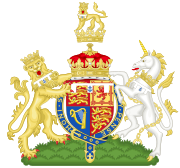 Arms of Prince Andrew, Duke of York Arms of Prince Andrew, Duke of York | |
| Creation date | 23 June 1986 |
| Creation | Eighth |
| Created by | Queen Elizabeth II |
| Peerage | Peerage of the United Kingdom |
| First holder | Edmund of Langley |
| Present holder | Prince Andrew |
| Remainder to | the 1st Duke's heirs male of the body lawfully begotten |
| Subsidiary titles | |
| Status | Extant |
| Seat(s) | Royal Lodge |
Duke of York is a title of nobility in the Peerage of the United Kingdom. Since the 15th century, it has, when granted, usually been given to the second son of English (later British) monarchs. The equivalent title in the Scottish peerage was Duke of Albany. However, King George II and King George III granted the titles Duke of York and Albany.
Initially granted in the 14th century in the Peerage of England, the title Duke of York has been created eight times. The title Duke of York and Albany has been created three times. These occurred during the 18th century, following the 1707 unification of the Kingdom of England and Kingdom of Scotland into a single, united realm. The double naming was done so that a territorial designation from each of the previously separate realms could be included.
The current Duke of York is Prince Andrew, the younger brother of King Charles III. The present Duke's marriage produced two daughters, and he has remained unmarried since his 1996 divorce.
The succession to the throne is regulated not only through descent, but also by Parliamentary statute. The order of succession is the sequence of members of the Royal Family in the order in which they stand in line to the throne. Andrew is currently 8th in the line of succession to the throne. https://www.royal.uk/encyclopedia/succession
History
In the Middle Ages, York was the main city of the North of England and the see of the Archbishop of York from AD 735. Yorkshire is England's largest shire in area.
York under its Viking name "Jorvik" was a petty kingdom in the Early Medieval period. In the interval between the fall of independent Jorvik under Eric Bloodaxe, last king of Jorvik (d. 954), and the first creation of the Dukedom of York, there were a few earls of York.
The title Duke of York was first created in the Peerage of England in 1385 for Edmund of Langley. His son Edward, who inherited the title, was killed at the Battle of Agincourt in 1415. The title passed to Edward's nephew Richard, the son of Richard of Conisburgh, 3rd Earl of Cambridge (who had been executed for plotting against King Henry V). The younger Richard managed to obtain a restoration of the title, but when his eldest son, who inherited the title, became king in 1461 as Edward IV, the title merged into the Crown.
The title was next created for Richard of Shrewsbury, second son of King Edward IV. Richard was one of the Princes in the Tower, and, as he died without heirs, the title became extinct at his death.
The third creation was for Henry Tudor, second son of King Henry VII. When his elder brother Arthur, Prince of Wales, died in 1502, Henry became heir-apparent to the throne. When Henry ultimately became King Henry VIII in 1509, his titles merged into the crown.
The title was created for the fourth time for Charles Stuart, second son of James I. When his elder brother, Henry Frederick, Prince of Wales, died in 1612, Charles became heir-apparent. He was created Prince of Wales in 1616 and eventually became Charles I in 1625 when the title again merged into the Crown.
The fifth creation was in favour of James Stuart, the second son of Charles I. New York, its capital Albany, and New York City, were named for this particular Duke of Albany and York. In 1664, Charles II of England granted American territory between the Delaware and Connecticut rivers to his younger brother James. Following its capture by the English the former Dutch territory of New Netherland and its principal port, New Amsterdam, were named the Province and City of New York in James's honour. After the founding, the Duke gave part of the colony to proprietors George Carteret and John Berkeley. Fort Orange, 150 miles (240 km) north on the Hudson River, was renamed Albany after James's Scottish title. When his elder brother, King Charles II, died without heirs, James succeeded to the throne as King James II of England and King James VII of Scotland, and the title once again merged into the Crown.
During the 18th century the double dukedom of York and Albany was created a number of times in the Peerage of Great Britain. The title was first held by Duke Ernest Augustus of Brunswick-Lüneburg, Bishop of Osnabrück, the youngest brother of King George I. He died without heirs, and the title reverted to the Crown. The second creation of the double dukedom was for Prince Edward, younger brother of King George III, who also died without heirs, having never married. Again, the title reverted to the Crown. The third and last creation of the double dukedom was for Prince Frederick Augustus, the second son of King George III. He served as Commander-in-Chief of the British Army for many years, and was the original "Grand old Duke of York" in the popular rhyme. He too died without legitimate heirs, leaving the title, once again, to revert to the Crown.
The sixth creation of the Dukedom of York (without being combined with Albany) was for Prince George, second son of the, then current, Prince of Wales, the future King Edward VII. He was created Duke of York following the death of his elder brother, Prince Albert Victor, Duke of Clarence and Avondale. The title merged with the Crown when George succeeded his father as King George V.
The seventh creation was for Prince Albert, second son of King George V, and younger brother of the future King Edward VIII. Albert came unexpectedly to the throne when his brother abdicated, and took the name George VI, the Dukedom then merging into the Crown.
The title was created for the eighth time for Prince Andrew, second son of Queen Elizabeth II. As of 2022, the only legitimate offspring are his two daughters from his marriage to Sarah, Duchess of York. Thus, if he has no future (legitimate) sons, the title will again become extinct—reverting to the Crown—upon his death.
Aside from the first creation, every time the Dukedom of York has been created it has had only one occupant, that person either inheriting the throne or dying without male heirs.
Pretenders
In the late 15th Century, Perkin Warbeck unsuccessfully claimed the Crown by claiming the identity of Richard of Shrewsbury, 1st Duke of York.
In the early 18th century, the eldest son of the overthrown King James II & VII and thus Jacobite claimant to the throne, James Francis Edward Stuart, known to his opponents as the Old Pretender, granted the title "Duke of York" (in the Jacobite Peerage) to his own second son, Henry, using his purported authority as King James III & VIII. Henry later became a cardinal in the Catholic church and is thus known as the Cardinal Duke of York. Since James was not recognised as king by English law, the grant is also not recognised as a legitimate creation.
Dukes of York
First creation, 1385–1461
| Duke | Portrait | Birth | Marriage(s) | Death |
|---|---|---|---|---|
| Edmund of Langley 1385–1402 also: Earl of Cambridge (1362) |

|
5 June 1341 Kings Langley 4th surviving son of King Edward III and Philippa of Hainault |
Isabella of Castile 11 July 1372 - 23 December 1392 3 children Joan Holland c. 4 November 1393 no children |
1 August 1402 |
| Edward of Norwich 1402–1415 also: Duke of Aumale (1397–1399), Earl of Cambridge (1362–1414), Earl of Rutland (1390–1402), Earl of Cork (c. 1396) |
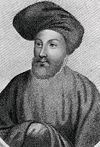
|
1373 Norwich son of 1st Duke by his first wife Isabella of Castile |
Philippa de Mohun no children |
25 October 1415 Battle of Agincourt aged 42 |
| Richard of York 1415–1460 also: Lord Protector of England, Prince of Wales and Earl of Chester, Duke of Cornwall (1460, see Act of Accord); Earl of Ulster (1264), Earl of March (1328), Earl of Cambridge (1414, restored 1426), feudal Lord of Clare (bt. 1066–1075), Baron Mortimer of Wigmore (1331) |
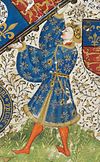
|
21 September 1411 Nephew of 2nd Duke and son of Richard of Conisburgh, 3rd Earl of Cambridge (attainted and executed for treason in August 1415) and Anne de Mortimer; restored in blood |
Cecily Neville 1437 13 children |
30 December 1460 Wakefield aged 49 |
| Edward Plantagenet 1460–1461 also: Earl of Ulster (1264), Earl of March (1328), Earl of Cambridge (1414), feudal Lord of Clare (bt. 1066–1075), Baron Mortimer of Wigmore (1331) |
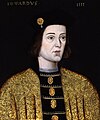
|
28 April 1442 Rouen son of 3rd Duke by his wife Cecily Neville |
Elizabeth Woodville 1 May 1464 10 children |
9 April 1483 Westminster aged 40 |
| Edward Plantagenet seized the throne in 1461 as Edward IV and the title of duke merged in the crown. | ||||
Second creation, 1474
| Duke | Portrait | Birth | Marriage(s) | Death |
|---|---|---|---|---|
| Richard of Shrewsbury 1474–1483 also: Duke of Norfolk (1477), Earl of Norfolk (1477), Earl of Nottingham (1476), possibly Earl of Warenne (1477) |

|
17 August 1473 Shrewsbury Second son of King Edward IV and Elizabeth Woodville |
Anne de Mowbray 15 January 1478 no children |
Disappeared in the Tower of London, with his older brother, the "Princes in the Tower". |
| Richard disappeared without known issue and the title of duke became extinct. | ||||
Third creation, 1494
| Duke | Portrait | Birth | Marriage(s) | Death |
|---|---|---|---|---|
| Henry Tudor 1494–1509 also: Prince of Wales (1504), Duke of Cornwall (1502) |
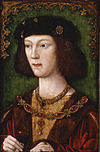
|
28 June 1491 Greenwich Palace, London son of Henry VII and Elizabeth of York |
Catherine of Aragon 11 June 1509 – 23 May 1533 (annulment) 1 surviving daughter, others stillborn or briefly-lived Anne Boleyn 25 January 1533 – 17 May 1536 (annulment) 1 daughter Jane Seymour 30 May 1536 – 24 October 1537 1 son Anne of Cleves 6 January 1540 – 9 July 1540 (annulment) no children Catherine Howard 28 July 1540 – 23 November 1541 no children Catherine Parr 12 July 1543 no children |
28 January 1547 Whitehall Palace, London aged 55 |
| Henry succeeded as Henry VIII in 1509 upon his father's death and the title of duke merged with the crown. | ||||
Fourth creation, 1605
| Duke | Portrait | Birth | Marriage(s) | Death |
|---|---|---|---|---|
| Charles Stuart 1605–1625 also: Duke of Albany (1600); Prince of Wales (1616), Duke of Cornwall and Duke of Rothesay (1612) |

|
19 November 1600 Dunfermline Palace, Dunfermline son of James I and Anne of Denmark |
Henrietta Maria of France 13 June 1625 9 children |
30 January 1649 Whitehall Palace, London aged 48 |
| Charles succeeded as Charles I in 1625 upon his father's death and the title of duke merged with the crown. | ||||
Fifth creation, 1633/1644
James was styled Duke of York from birth and officially created as such in 1644.
| Duke | Portrait | Birth | Marriage(s) | Death |
|---|---|---|---|---|
| James Stuart 1633/1644–1685 also: Duke of Albany (1660), Earl of Ulster (1659) |
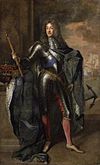
|
14 October 1633 St. James's Palace, London son of Charles I and Henrietta Maria of France |
Anne Hyde 3 September 1660 8 children Mary of Modena 21 November 1673 7 children |
16 September 1701 Château de Saint-Germain-en-Laye, Paris aged 67 |
| James succeeded as James II in 1685 upon his brother's death and the title of duke merged with the crown. | ||||
Jacobite creation, 1725
| Duke | Portrait | Birth | Marriage(s) | Death |
|---|---|---|---|---|
| Henry Benedict Stuart 1725–1788 also: Cardinal of the Holy Roman Church (1747), Dean of the College of Cardinals (1803) |
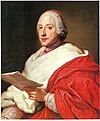
|
6 March 1725 Palazzo Muti Rome Papal States son of "James III and VIII" (Jacobite Pretender) and Maria Clementina Sobieska |
____ | 13 July 1807 Frascati, Rome aged 82 |
| Henry succeeded his brother as Jacobite pretender to the thrones of England, Ireland and Scotland in 1788, calling himself "Henry IX", but was not recognized in Britain as a Duke, let alone as King. | ||||
Sixth creation, 1892
| Duchess | Portrait | Birth | Marriage(s) | Death | Arms |
|---|---|---|---|---|---|
| George Frederick Ernest Albert House of Saxe-Coburg and Gotha 1892–1910 also: Earl of Inverness and Baron Killarney (1892); Prince of Wales, Duke of Cornwall, and Duke of Rothesay (1901) |
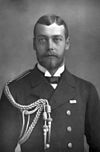
|
3 June 1865 Marlborough House son of Edward VII and Alexandra of Denmark |
Mary of Teck 6 July 1893 6 children |
20 January 1936 Sandringham House, Sandringham aged 70 |

|
| George succeeded as George V in 1910 upon his father's death and the title of duke merged with the crown. | |||||
Seventh creation, 1920
| Duchess | Portrait | Birth | Marriage(s) | Death | Arms |
|---|---|---|---|---|---|
| Albert Frederick Arthur George House of Windsor 1920–1936 also: Earl of Inverness and Baron Killarney (1920) |

|
14 December 1895 Sandringham House, Sandringham son of George V and Mary of Teck |
Elizabeth Bowes-Lyon 26 April 1923 2 daughters |
6 February 1952 Sandringham House, Sandringham aged 56 |

|
| Albert succeeded as George VI in 1936 upon his brother's abdication and the title of duke merged with the crown. As Albert had no male issue, the title would have gone extinct in any case, even if he had not become king. | |||||
Eighth creation, 1986
| Duchess | Portrait | Birth | Marriage(s) | Death | Arms |
|---|---|---|---|---|---|
| Andrew Albert Christian Edward House of Windsor 1986 also: Earl of Inverness and Baron Killyleagh (1986) |

|
19 February 1960 Buckingham Palace son of Elizabeth II and Prince Philip, Duke of Edinburgh |
Sarah Ferguson 23 July 1986 – 30 May 1996 (divorce) 2 daughters |
– now 64 years, 333 days old |

|
| Prince Andrew has no male heirs as of 2024 and all his titles will become extinct on his death. | |||||
Family trees
| Family tree: Dukes of York, Dukes of Albany, Dukes of York and Albany, and Earls of Ulster | |||||||||||||||||||||||||||||||||||||||||||||||||||||||||||||||||||||||||||||||||||||||||||||||||||||||||||||||||||||||||||||||||||||||||||||||||||||||||||||||||||||||||||||||||||||||||||||||||||||||||||||||||||||||||||||||||||||||||||||||||||||||||||||||||||||||||||||||||||||||||||||||||||||||||||||||||||||||||||||||||||||||||||||||||||||||||||||||||||||||||||||||||||||||||||||||||||||||||||||||||||||||||||||||||||||||||||||||||||||||||||||||||||||||||||||||||||||||||||||||||||||||||||||||||||||||||||||||||||||||||||||||||||||||||||||||||||||||||||||||||||||||||||||||||||||||||||||||||||||||||||||||||||||||||||||||||||||||||||||||||||||||||||||||||||||||||||||||||||||||||||||||||||||||||||||||||||||||||||||||||||||||||||||||||||||||||||||||||||||||||||||||||||||||||||||||||||||||||||||||||||||||||||||||||||||||||||||||||||||||||||||||||||||||||||||||||||||||||||||||||||||||||||||||||||||||||||||||||||||||||||||||||||||||||||||||||||||||||||||||||||||||||||||||||||||||||||||||||||||||
|---|---|---|---|---|---|---|---|---|---|---|---|---|---|---|---|---|---|---|---|---|---|---|---|---|---|---|---|---|---|---|---|---|---|---|---|---|---|---|---|---|---|---|---|---|---|---|---|---|---|---|---|---|---|---|---|---|---|---|---|---|---|---|---|---|---|---|---|---|---|---|---|---|---|---|---|---|---|---|---|---|---|---|---|---|---|---|---|---|---|---|---|---|---|---|---|---|---|---|---|---|---|---|---|---|---|---|---|---|---|---|---|---|---|---|---|---|---|---|---|---|---|---|---|---|---|---|---|---|---|---|---|---|---|---|---|---|---|---|---|---|---|---|---|---|---|---|---|---|---|---|---|---|---|---|---|---|---|---|---|---|---|---|---|---|---|---|---|---|---|---|---|---|---|---|---|---|---|---|---|---|---|---|---|---|---|---|---|---|---|---|---|---|---|---|---|---|---|---|---|---|---|---|---|---|---|---|---|---|---|---|---|---|---|---|---|---|---|---|---|---|---|---|---|---|---|---|---|---|---|---|---|---|---|---|---|---|---|---|---|---|---|---|---|---|---|---|---|---|---|---|---|---|---|---|---|---|---|---|---|---|---|---|---|---|---|---|---|---|---|---|---|---|---|---|---|---|---|---|---|---|---|---|---|---|---|---|---|---|---|---|---|---|---|---|---|---|---|---|---|---|---|---|---|---|---|---|---|---|---|---|---|---|---|---|---|---|---|---|---|---|---|---|---|---|---|---|---|---|---|---|---|---|---|---|---|---|---|---|---|---|---|---|---|---|---|---|---|---|---|---|---|---|---|---|---|---|---|---|---|---|---|---|---|---|---|---|---|---|---|---|---|---|---|---|---|---|---|---|---|---|---|---|---|---|---|---|---|---|---|---|---|---|---|---|---|---|---|---|---|---|---|---|---|---|---|---|---|---|---|---|---|---|---|---|---|---|---|---|---|---|---|---|---|---|---|---|---|---|---|---|---|---|---|---|---|---|---|---|---|---|---|---|---|---|---|---|---|---|---|---|---|---|---|---|---|---|---|---|---|---|---|---|---|---|---|---|---|---|---|---|---|---|---|---|---|---|---|---|---|---|---|---|---|---|---|---|---|---|---|---|---|---|---|---|---|---|---|---|---|---|---|---|---|---|---|---|---|---|---|---|---|---|---|---|---|---|---|---|---|---|---|---|---|---|---|---|---|---|---|---|---|---|---|---|---|---|---|---|---|---|---|---|---|---|---|---|---|---|---|---|---|---|---|---|---|---|---|---|---|---|---|---|---|---|---|---|---|---|---|---|---|---|---|---|---|---|---|---|---|---|---|---|---|---|---|---|---|---|---|---|---|---|---|---|---|---|---|---|---|---|---|---|---|---|---|---|---|---|---|---|---|---|---|---|---|---|---|---|---|---|---|---|---|---|---|---|---|---|---|---|---|---|---|---|---|---|---|---|---|---|---|---|---|---|---|---|---|---|---|---|---|---|---|---|---|---|---|---|---|---|---|---|---|---|---|---|---|---|---|---|---|---|---|---|---|---|---|---|---|---|---|---|---|---|---|---|---|---|---|---|---|---|---|---|---|---|---|---|---|---|---|---|---|---|---|---|---|---|---|---|---|---|---|---|---|---|---|---|---|---|---|---|---|---|---|---|---|---|---|---|---|---|---|---|---|---|---|---|---|---|---|---|---|---|---|---|---|---|---|---|---|---|---|---|---|---|---|---|---|---|---|---|---|---|---|---|---|---|---|---|---|---|---|---|---|---|---|---|---|---|---|---|---|---|---|---|---|---|---|---|---|---|---|---|---|---|---|---|---|---|---|---|---|---|---|---|---|---|---|---|---|---|---|---|---|---|---|---|---|---|---|---|---|---|---|---|---|---|---|---|---|---|---|---|---|---|---|---|---|---|---|---|---|---|---|---|---|---|---|---|---|---|---|---|---|---|---|---|---|---|---|---|---|---|---|---|---|---|---|---|---|---|---|---|---|---|---|---|---|---|---|---|---|---|---|---|---|---|---|---|---|---|---|---|---|---|---|---|---|---|---|---|---|---|---|---|---|---|---|---|---|---|---|---|---|---|---|---|---|---|---|---|---|---|---|---|---|---|---|---|---|---|---|---|---|---|---|---|---|---|---|---|---|---|---|---|---|---|---|---|---|---|---|---|---|---|---|---|---|---|---|---|---|---|---|---|---|---|---|---|---|---|---|---|---|---|---|---|---|---|---|---|---|---|---|---|---|---|---|---|---|---|---|---|---|---|---|---|---|
| |||||||||||||||||||||||||||||||||||||||||||||||||||||||||||||||||||||||||||||||||||||||||||||||||||||||||||||||||||||||||||||||||||||||||||||||||||||||||||||||||||||||||||||||||||||||||||||||||||||||||||||||||||||||||||||||||||||||||||||||||||||||||||||||||||||||||||||||||||||||||||||||||||||||||||||||||||||||||||||||||||||||||||||||||||||||||||||||||||||||||||||||||||||||||||||||||||||||||||||||||||||||||||||||||||||||||||||||||||||||||||||||||||||||||||||||||||||||||||||||||||||||||||||||||||||||||||||||||||||||||||||||||||||||||||||||||||||||||||||||||||||||||||||||||||||||||||||||||||||||||||||||||||||||||||||||||||||||||||||||||||||||||||||||||||||||||||||||||||||||||||||||||||||||||||||||||||||||||||||||||||||||||||||||||||||||||||||||||||||||||||||||||||||||||||||||||||||||||||||||||||||||||||||||||||||||||||||||||||||||||||||||||||||||||||||||||||||||||||||||||||||||||||||||||||||||||||||||||||||||||||||||||||||||||||||||||||||||||||||||||||||||||||||||||||||||||||||||||||||||
| Family tree of Royal dukes in the United Kingdom | |||||||||||||||||||||||||||||||||||||||||||||||||||||||||||||||||||||||||||||||||||||||||||||||||||||||||||||||||||||||||||||||||||||||||||||||||||||||||||||||||||||||||||||||||||||||||||||||||||||||||||||||||||||||||||||||||||||||||||||||||||||||||||||||||||||||||||||||||||||||||||||||||||||||||||||||||||||||||||||||||||||||||||||||||||||||||||||||||||||||||||||||||||||||||||||||||||||||||||||||||||||||||||||||||||||||||||||||||||||||||||||||||||||||||||||||||||||||||||||||||||||||||||||||||||||||||||||||||||||||||||||||||||||||||||||||||||||||||||||||||||||||||||||||||||||||||||||||||||||||||||||||||||||||||||||||||||||||||||||||||||||||||||||||||||||||||||||||||||||||||||||||||||||||||||||||||||||||||||||||||||||||||||||||||||||||||||||||||||||||||||||||||||||||||||||||||||||||||||||||||||||||||||||||||||||||||||||||||||||||||||||||||||||||||||||||||||||||||||||||||||||||||||||||||||||||||||||||||||||||||||||||||||||||||||||||||||||||||||||||||||||||||||||||||||||||||||||||||||||||
|---|---|---|---|---|---|---|---|---|---|---|---|---|---|---|---|---|---|---|---|---|---|---|---|---|---|---|---|---|---|---|---|---|---|---|---|---|---|---|---|---|---|---|---|---|---|---|---|---|---|---|---|---|---|---|---|---|---|---|---|---|---|---|---|---|---|---|---|---|---|---|---|---|---|---|---|---|---|---|---|---|---|---|---|---|---|---|---|---|---|---|---|---|---|---|---|---|---|---|---|---|---|---|---|---|---|---|---|---|---|---|---|---|---|---|---|---|---|---|---|---|---|---|---|---|---|---|---|---|---|---|---|---|---|---|---|---|---|---|---|---|---|---|---|---|---|---|---|---|---|---|---|---|---|---|---|---|---|---|---|---|---|---|---|---|---|---|---|---|---|---|---|---|---|---|---|---|---|---|---|---|---|---|---|---|---|---|---|---|---|---|---|---|---|---|---|---|---|---|---|---|---|---|---|---|---|---|---|---|---|---|---|---|---|---|---|---|---|---|---|---|---|---|---|---|---|---|---|---|---|---|---|---|---|---|---|---|---|---|---|---|---|---|---|---|---|---|---|---|---|---|---|---|---|---|---|---|---|---|---|---|---|---|---|---|---|---|---|---|---|---|---|---|---|---|---|---|---|---|---|---|---|---|---|---|---|---|---|---|---|---|---|---|---|---|---|---|---|---|---|---|---|---|---|---|---|---|---|---|---|---|---|---|---|---|---|---|---|---|---|---|---|---|---|---|---|---|---|---|---|---|---|---|---|---|---|---|---|---|---|---|---|---|---|---|---|---|---|---|---|---|---|---|---|---|---|---|---|---|---|---|---|---|---|---|---|---|---|---|---|---|---|---|---|---|---|---|---|---|---|---|---|---|---|---|---|---|---|---|---|---|---|---|---|---|---|---|---|---|---|---|---|---|---|---|---|---|---|---|---|---|---|---|---|---|---|---|---|---|---|---|---|---|---|---|---|---|---|---|---|---|---|---|---|---|---|---|---|---|---|---|---|---|---|---|---|---|---|---|---|---|---|---|---|---|---|---|---|---|---|---|---|---|---|---|---|---|---|---|---|---|---|---|---|---|---|---|---|---|---|---|---|---|---|---|---|---|---|---|---|---|---|---|---|---|---|---|---|---|---|---|---|---|---|---|---|---|---|---|---|---|---|---|---|---|---|---|---|---|---|---|---|---|---|---|---|---|---|---|---|---|---|---|---|---|---|---|---|---|---|---|---|---|---|---|---|---|---|---|---|---|---|---|---|---|---|---|---|---|---|---|---|---|---|---|---|---|---|---|---|---|---|---|---|---|---|---|---|---|---|---|---|---|---|---|---|---|---|---|---|---|---|---|---|---|---|---|---|---|---|---|---|---|---|---|---|---|---|---|---|---|---|---|---|---|---|---|---|---|---|---|---|---|---|---|---|---|---|---|---|---|---|---|---|---|---|---|---|---|---|---|---|---|---|---|---|---|---|---|---|---|---|---|---|---|---|---|---|---|---|---|---|---|---|---|---|---|---|---|---|---|---|---|---|---|---|---|---|---|---|---|---|---|---|---|---|---|---|---|---|---|---|---|---|---|---|---|---|---|---|---|---|---|---|---|---|---|---|---|---|---|---|---|---|---|---|---|---|---|---|---|---|---|---|---|---|---|---|---|---|---|---|---|---|---|---|---|---|---|---|---|---|---|---|---|---|---|---|---|---|---|---|---|---|---|---|---|---|---|---|---|---|---|---|---|---|---|---|---|---|---|---|---|---|---|---|---|---|---|---|---|---|---|---|---|---|---|---|---|---|---|---|---|---|---|---|---|---|---|---|---|---|---|---|---|---|---|---|---|---|---|---|---|---|---|---|---|---|---|---|---|---|---|---|---|---|---|---|---|---|---|---|---|---|---|---|---|---|---|---|---|---|---|---|---|---|---|---|---|---|---|---|---|---|---|---|---|---|---|---|---|---|---|---|---|---|---|---|---|---|---|---|---|---|---|---|---|---|---|---|---|---|---|---|---|---|---|---|---|---|---|---|---|---|---|---|---|---|---|---|---|---|---|---|---|---|---|---|---|---|---|---|---|---|---|---|---|---|---|---|---|---|---|---|---|---|---|---|---|---|---|---|---|---|---|---|---|---|---|---|---|---|---|---|---|---|---|---|---|---|---|---|---|---|---|---|---|---|---|---|---|---|---|---|---|---|---|---|---|---|---|---|---|---|---|---|---|---|---|---|---|---|---|---|---|---|---|---|---|---|---|---|---|---|---|---|---|---|---|---|
|
Includes dukes of: Albany, Albemarle, Bedford, Cambridge, Clarence, Connaught and Strathearn, Cumberland, Edinburgh, Gloucester, Gloucester and Edinburgh, Hereford, Kent, Kintyre and Lorne, Norfolk, Ross, Somerset, Sussex, Windsor, and York, but only when royally. Non-royal dukes are not included; see Royal dukedoms in the United Kingdom.
| |||||||||||||||||||||||||||||||||||||||||||||||||||||||||||||||||||||||||||||||||||||||||||||||||||||||||||||||||||||||||||||||||||||||||||||||||||||||||||||||||||||||||||||||||||||||||||||||||||||||||||||||||||||||||||||||||||||||||||||||||||||||||||||||||||||||||||||||||||||||||||||||||||||||||||||||||||||||||||||||||||||||||||||||||||||||||||||||||||||||||||||||||||||||||||||||||||||||||||||||||||||||||||||||||||||||||||||||||||||||||||||||||||||||||||||||||||||||||||||||||||||||||||||||||||||||||||||||||||||||||||||||||||||||||||||||||||||||||||||||||||||||||||||||||||||||||||||||||||||||||||||||||||||||||||||||||||||||||||||||||||||||||||||||||||||||||||||||||||||||||||||||||||||||||||||||||||||||||||||||||||||||||||||||||||||||||||||||||||||||||||||||||||||||||||||||||||||||||||||||||||||||||||||||||||||||||||||||||||||||||||||||||||||||||||||||||||||||||||||||||||||||||||||||||||||||||||||||||||||||||||||||||||||||||||||||||||||||||||||||||||||||||||||||||||||||||||||||||||||||
Places and things named after the dukes of York
Geographic features
Southern hemisphere
- Cape York Peninsula, Australia
- Duke of York Island, Antarctica
- Duke of York Island, Papua New Guinea
- Duke of York Islands, Papua New Guinea
Canada
- Duke of York Archipelago, Canada
- Duke of York Bay, Canada
Political entities
Canada
- York, Upper Canada, now Toronto, Ontario
- York County, New Brunswick, Canada
United States
- New York, a U.S. state
- New York City, the largest city in the state of New York.
Schools
- Duke of York's Royal Military School, Dover, Kent, United Kingdom
- Duke of York School, Nairobi, Kenya, renamed Lenana School after Kenya attained independence in 1963.
Pubs
- Duke of York, Bloomsbury
- Duke of York Inn, Elton
- The Duke of York, Fitzrovia
- Duke of York, Ganwick Corner
Ships
- HMS Duke of York (1763), a 4-gun cutter purchased in 1763 and sold in 1776
- HMS Duke of York (17), a King George V-class battleship launched in 1940, and broken up in 1958
- Hired armed cutter Duke of York
- Hired armed lugger Duke of York
- TSS Duke of York (1894)
- TSS Duke of York (1935)
Railroad Equipment
- Duke of York was one of the GWR 3031 Class locomotives that were built for and run on the Great Western Railway between 1891 and 1915.
Military Music
There is also military march titled Duke of York which is used as an inspection piece or slow march. It is in 4/4 time, D Major with a form of AABBCCDD. Gordon Ashman in 1991 maintains that the melody was composed in 1805, soon after the Duke of York became Colonel of the Grenadier Guards, and notes it is still in use today as a regimental slow-march. James Merryweather however, researched the melody and found it was composed by John Gamidge in 1789, to be played by the York Waits. https://www.youtube.com/watch?v=hU0PqAZLeew
See also
- Duke of Albany
- Duke of York and Albany
- Earl of Inverness, a subsidiary title of the current creation
- Baron Killyleagh, a subsidiary title of the current creation
- Henry Benedict Stuart, created Duke of York in the Jacobite Peerage by his father the titular King James III in 1725. Living in Italy as a cardinal of the Roman Catholic Church, he called himself the "Cardinal Duke of York" (or "Cardinal called Duke of York") for most of his life and was recognised as such by the Papacy, Modena, France, and Spain. He became the Jacobite pretender himself as "Henry IX" in 1788. The last surviving legitimate descendant of James II, his grandfather, he died without issue in 1807.
References
- "New York". Microsoft Encarta Online Encyclopedia 2006. Archived from the original on 28 October 2009. Retrieved 24 February 2007.
- "James II". Encyclopædia Britannica Online. Encyclopædia Britannica. Retrieved 2 January 2011.
- Miller, 44–45
- Encyclopædia Britannica Edmund of Langley First Duke of York
- Encyclopædia Britannica Edward of Norwich Second Duke of York
- English Monarchs
- BBC Edward IV
- Scarisbrick, J. J. (1997). Henry VIII (2nd ed.). Yale University Press. ISBN 0300071582.
- Gregg, Pauline (1981), King Charles I, London: Dent
- ^ Callow, John, The Making of King James II: The Formative Years of a King, Sutton Publishing, Ltd, Stroud, Gloucestershire, 2000. Page
- "Page 6313 | Supplement 31931, 4 June 1920 | London Gazette | the Gazette".
- "Page 1 | Supplement 50606, 23 July 1986 | London Gazette | the Gazette".–present
- "Cape York". Encyclopaedia Britannica. Retrieved 13 December 2017.
- Scadding, Henry (1873). Toronto of old: collections and recollections illustrative of the early settlement and social life of the capital of Ontario. Toronto, ON.: Adam, Stevenson & Co. p. 21. Retrieved 13 December 2017.
- "York County". Where is Home? New Brunswick Communities Past and Present. Provincial Archives of New Brunswick. Retrieved 13 December 2017.
- ^ "New York Under The Duke of York". Empire State History. Archived from the original on 3 January 2018. Retrieved 13 December 2017.
- "The Duke of York March". YouTube. 26 March 2016.
Sources
- Miller, John (2000). James II, 3rd ed. ISBN 0-300-08728-4.
External links
- The Duke of York at the Royal Family website
| Dukes of York | |
|---|---|
| |
| italics denote Dukes of York and Albany |
| Extant dukedoms in the peerages of Britain and Ireland | ||
|---|---|---|
| Royal dukedoms |  | |
| England | ||
| Scotland | ||
| Great Britain | ||
| Ireland | ||
| United Kingdom | ||
| Italics: This title is held by a peer who holds another of higher precedence. | ||
- Dukes of York
- 1385 establishments in England
- 1892 establishments in the United Kingdom
- Dukedoms in the Peerage of the United Kingdom
- British and Irish peerages which merged in the Crown
- Noble titles created in 1385
- Noble titles created in 1474
- Noble titles created in 1494
- Noble titles created in 1605
- Noble titles created in 1644
- Noble titles created in 1725
- Noble titles created in 1892
- Noble titles created in 1920
- Noble titles created in 1986
- Dukedoms in the Jacobite Peerage